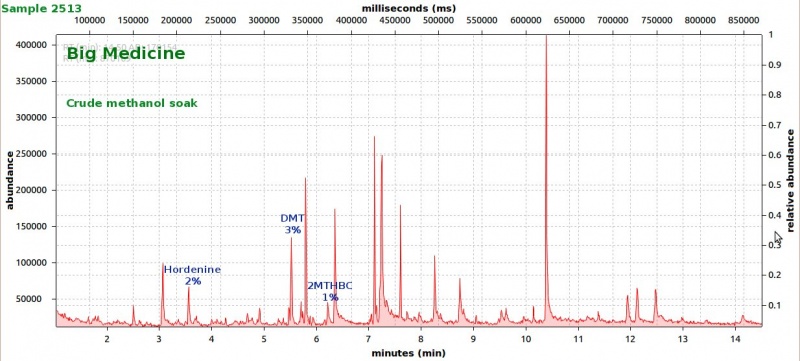Phalaris growth and harvest conditions and alkaloid contentTo increase Phalaris alkaloid content, fertilize with ammonium sulfate (
Parmar, 1974), and grow in partial shadow, 28% sunlight (
Festi & Samorini 1994). Cut and discard the first grow, and instead harvest the top half of the regrowth at day 7 after stressing it with low water and harvesting at the first signs of leaves reducing their fullness/showing lack of water (
Idem). Harvest early morning (6:00am) for more DMT or late morning (10:00am) to increase 5-MeO-DMT (only in the plants that already have either alkaloid. Some strains will not produce 5-MeO-DMT or DMT no matter what time you harvest) (
Williams 1972). It should processed as fresh plant material to prevent enzymatic activity which decreases alkaloid content (
Barnes et al 1971, Donker et al 1976). If immediate processing is not possible, maybe alcohol soak and freezing ASAP should be attempted.
Phalaris arundinacea (dry)
0.09 - 0.33 % "indole alkaloids" (
Marten et al 1981)
Hordenine (major compound), Gramine, 5-MeO-NMT, 2,9-dimethyl-6-methoxy-1,2,3,4-tetrahydro-B-carboline, and two other substances initially identified as 5-Meo-Tryptamine and 5-Methyl-Tryptamine but later separated chromatographically so probaby wrong ID (
Audette et al 1969)
Only a minority of samples contained a significant amount of 5-MeO-DMT or DMT, most expressed gramine (
Ostrem 1987)
Hordenine, Gramine, DMT, NMT, 5-MeO-NMT, 5-MeO-DMT, 2-MTHBC, 2-Me-6-MeO-THBC, 2,9-Me-6-MeO-THBC are alkaloids shown so far in species but not in same specimens (
Ostrem 1987)
Gramine, tryptophol, lupanine, 13-OH lupanine and lupanine esters ( 13α-isovalericlupanine and 13α-tigloyloxylupanine (
Grzelak et al 2018)
Phalaris aquatica (dry)
Specimen 1: 0.02575 % N-Methyl-Tyramine, 0.0177 % DMT, 0.0176 % 5-MeO-DMT, 0.0076 % Hordenine, 0.00475 % Gramine
Specimen 2: 0.01938 % N-Methyl-Tyramine, 0.0066 % DMT, 0.00575 % Hordenine, 0.0045 % Gramine
Specimen 3: 0.08338 % Hordenine, 0.02625 % N-Methyl-Tyramine
Specimen 4: 0.0266 % Hordenine, 0.0171 % N-Methyl-Tyramine
Specimen 5: 0.0221 % N-Methyl-Tyramine, 0.0022 % Gramine
(
Zhou et al 2006)
(published as Phalaris tuberosa, which is a synonym to Phalaris aquatica) (dry)
(Williams 1972) 0.028 - 0.06% DMT
0.003 - 0.025% 5-MeO-DMT
0.0007 - 0.0045% Bufotenine
(Ratio was around 1:1 or 2:1 DMT:5-MeO-DMT at 10:00AM but 4:1 or 20:1 at 6:00AM)
General info:
FAQ: How to extract from Phalaris (with info on better solvents and teks, and sum up of conditions that affect alkaloid content from publication above)
Phalaris identification thread
Phalaris way of the future thread - With a lot of info on Phalaris, other alkaloids found in it, growing, extracting, etc.
PDF on processing/extracting phalaris
Phalaris containing DMTPhalaris containing 5-MeO-DMTPhalaris containing bufotenineNexus Analysis

Note: The image below does NOT imply Yugo Red has a clean alkaloid profile, since the plant is the same as the image above, it just means that cold limonene pull seems to serve well to separate DMT from other alkaloids, but the overal quantity of DMT after this was very small



Benzyme also analysed Phalarys Brachystachis with a ratio of 9:1 DMT to gramine.
Notes: The other Big Medicine peaks seem to be similar to the other phalaris crude methanol samples, mostly fatty acids and inactive plant material. The caffeine contaminant was not on my part, I re-ran with new grass from samples I had and it still had caffeine, so it must have come from the person that cultivated it. The harmine contam in sample 123 was probably neither on my part. I will re-test this sample in the near future just to make sure. I dont think harmine is in phalaris.
If other peaks are identified, I will post the results here. New phalaris analysis to come in the future.
Also as always, im posting the *.ms files for whoever wants to check the mass spectra themselves (I suggest any chem-expert SHOULD double check my work). All ratios and relative amounts here are approx, meant for general informative purposes. Accurate quantification is significantly more trouble and im just starting with analysis, I need more experience first. Propper absolute quantification, not just approx relative values, might be done in the future, stay tuned
GC-MS details below. In the future LC-MS will also be used, and details also added here.
Quote:GC-MS analysis was performed in an Agilent 5890 series II gas chromatograph coupled to an 5971A quadrupole mass spectrometer detector (Agilent). The gas chromatograph was fitted with an 6890 auto sampler injector. Samples were injected in split mode into a 12m × 0.2mm i.d., 0.33 µm film thickness 5% phenylmethylsilicone column (ULTRA-2, Agilent Technologies). The oven temperature was programmed at 90ºC during 2min and increased 20ºC/min to 300ºC. Finally was maintained at 300ºC over 4min with a total run time of 14.50min. Insert liners packed with silanized glasswool were used. The injector and the interface were operated at 280 ◦C. Helium was used as carrier gas at a flow rate of 0.48ml/min. The mass spectrometer was operated in electron impact ionization mode at 70 eV